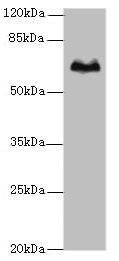Description
| Antibody Name: | TBX15 Antibody (PACO38766) |
| Antibody SKU: | PACO38766 |
| Size: | 50ug |
| Host Species: | Rabbit |
| Tested Applications: | ELISA, WB |
| Recommended Dilutions: | ELISA:1:2000-1:10000, WB:1:1000-1:5000 |
| Species Reactivity: | Human |
| Immunogen: | Recombinant Human T-box transcription factor TBX15 protein (1-496AA) |
| Form: | Liquid |
| Storage Buffer: | Preservative: 0.03% Proclin 300 Constituents: 50% Glycerol, 0.01M PBS, PH 7.4 |
| Purification Method: | >95%, Protein G purified |
| Clonality: | Polyclonal |
| Isotype: | IgG |
| Conjugate: | Non-conjugated |
 | Western blot. All lanes: TBX15 antibody at 5µg/ml + Hela whole cell lysate. Secondary. Goat polyclonal to rabbit IgG at 1/10000 dilution. Predicted band size: 66, 55 kDa. Observed band size: 66 kDa. |
| Background: | Probable transcriptional regulator involved in the development of the skeleton of the limb, vertebral column and head. Acts by controlling the number of mesenchymal precursor cells and chondrocytes (By similarity). |
| Synonyms: | T-box transcription factor TBX15 (T-box protein 15) (T-box transcription factor TBX14) (T-box protein 14), TBX15, TBX14 |
| UniProt Protein Function: | TBX15: Probable transcriptional regulator involved in the development of the skeleton of the limb, vertebral column and head. Acts by controlling the number of mesenchymal precursor cells and chondrocytes. Defects in TBX15 are the cause of Cousin syndrome (COUSS); also known as craniofacial dysmorphism, hypoplasia of scapula and pelvis, and short stature. Cousin syndrome is defined as pelviscapular dysplasia with epiphyseal abnormalities, congenital dwarfism and facial dysmorphy (frontal bossing, hypertelorism, narrow palpebral fissures, deep set globes, strabismus, low-set posteriory rotated and unusually formed external ears, dysplasia of conchae, small chin, short neck with redundant skin folds, and a low hairline). Intelligence may vary from normal to moderately impaired. Radiographic features comprise aplasia of the body of the scapula, hypoplasia of the iliac bone, humeroradial synosthosis, dislocation of the femoral heads, and moderate brachydactyly. 2 isoforms of the human protein are produced by alternative splicing. |
| UniProt Protein Details: | Protein type:DNA-binding Chromosomal Location of Human Ortholog: 1p11.1 Molecular Function:protein binding Disease: Cousin Syndrome |
| NCBI Summary: | This gene belongs to the T-box family of genes, which encode a phylogenetically conserved family of transcription factors that regulate a variety of developmental processes. All these genes contain a common T-box DNA-binding domain. Mutations in this gene are associated with Cousin syndrome.[provided by RefSeq, Oct 2009] |
| UniProt Code: | Q96SF7 |
| NCBI GenInfo Identifier: | 59803103 |
| NCBI Gene ID: | 6913 |
| NCBI Accession: | Q96SF7.2 |
| UniProt Secondary Accession: | Q96SF7,Q08E76, Q5JT54, Q5T9S7, |
| UniProt Related Accession: | Q96SF7 |
| Molecular Weight: | 54,671 Da |
| NCBI Full Name: | T-box transcription factor TBX15 |
| NCBI Synonym Full Names: | T-box 15 |
| NCBI Official Symbol: | TBX15 |
| NCBI Official Synonym Symbols: | TBX14 |
| NCBI Protein Information: | T-box transcription factor TBX15 |
| UniProt Protein Name: | T-box transcription factor TBX15 |
| UniProt Synonym Protein Names: | T-box transcription factor TBX14; T-box protein 14 |
| Protein Family: | T-box transcription factor |
| UniProt Gene Name: | TBX15 |
| UniProt Entry Name: | TBX15_HUMAN |






